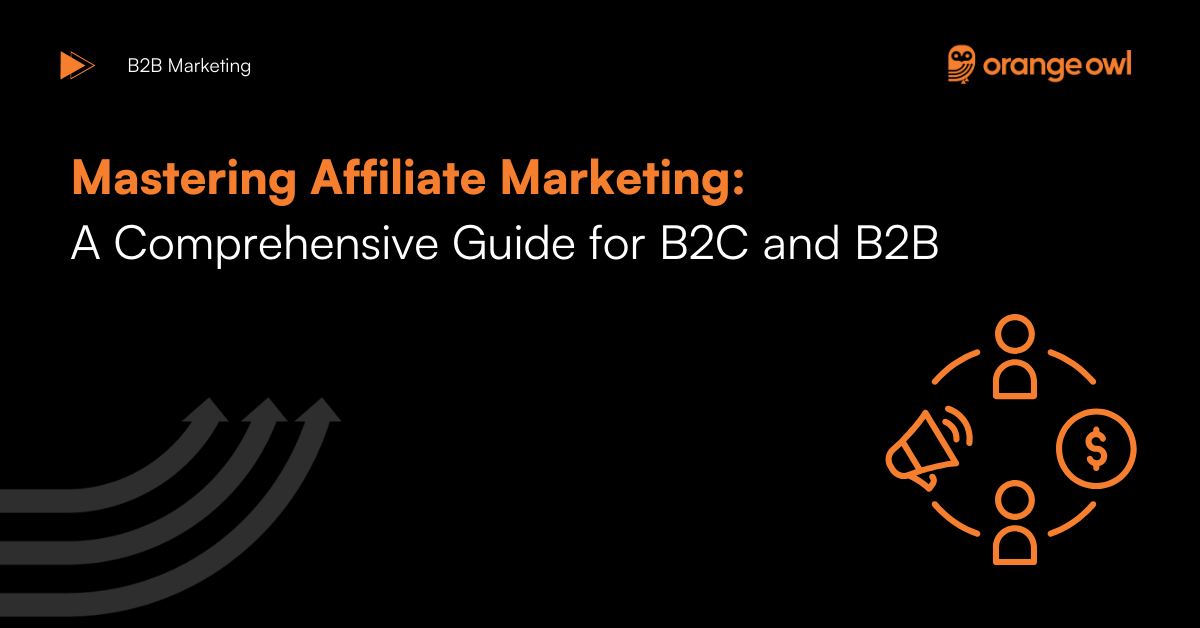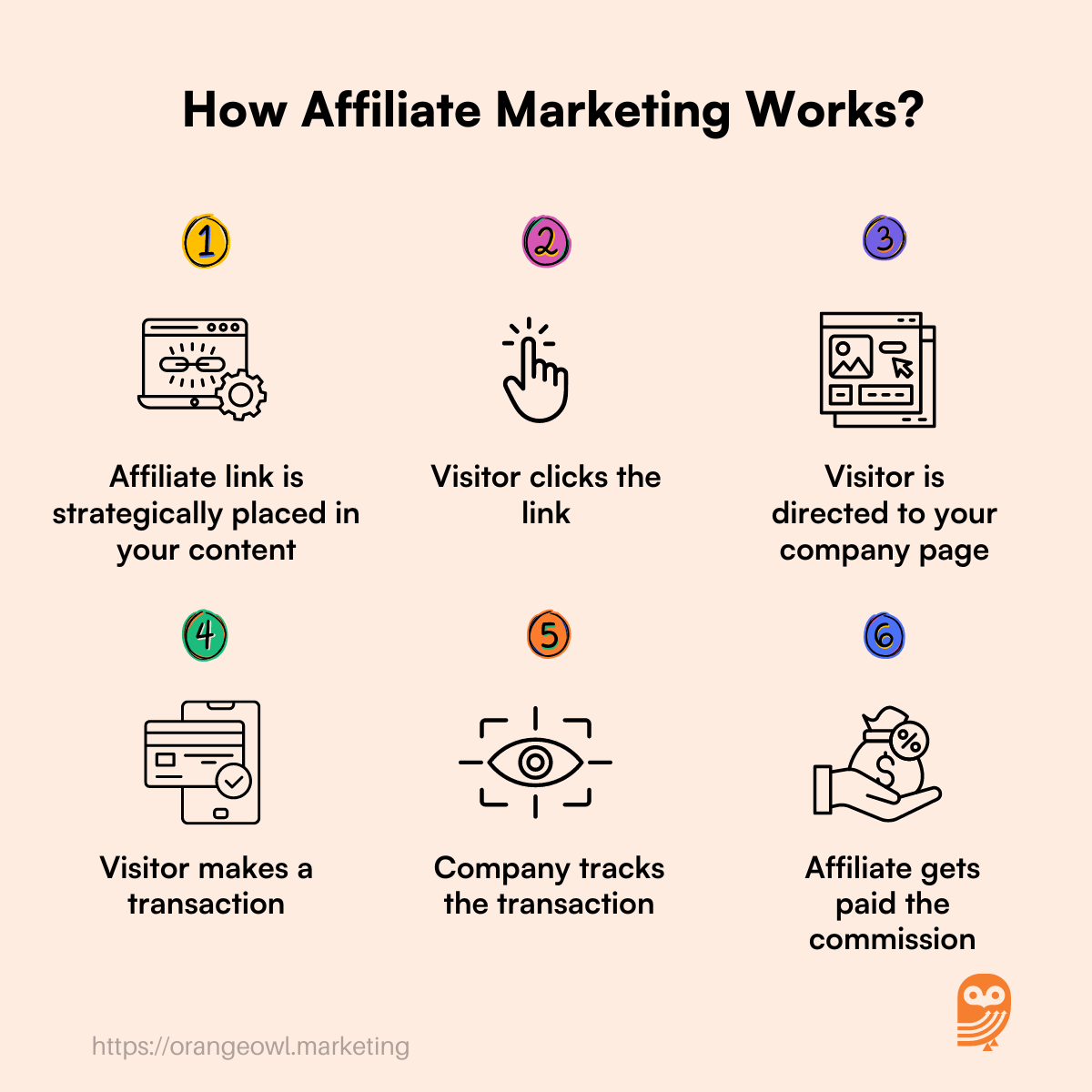Mastering Affiliate Marketing: A Comprehensive Guide for B2C and B2B
Vivek Goel
July 16, 2024

Table of Contents
Affiliate marketing has become a crucial strategy in the digital marketing landscape. Whether you’re a B2C or B2B company, understanding and leveraging affiliate marketing can significantly enhance your online presence and revenue. This comprehensive guide will delve into what affiliate marketing is, its relevance to different business models, the common confusions surrounding it, and provide detailed steps and best practices to set up and optimize an affiliate marketing program.
What is Affiliate Marketing?
Affiliate marketing is a performance-based marketing strategy where a business rewards affiliates (partners) for driving traffic or sales through the affiliate’s marketing efforts. Affiliates earn a commission for each customer they bring to the business, usually via tracked links. This method leverages the power of networks and partnerships to expand a company’s reach.

Key Components:
- Merchants: Businesses that sell products or services.
- Affiliates: Individuals or companies promoting the merchant’s products to earn commissions.
- Customers: End-users who purchase the products or services.
- Affiliate Networks: Platforms that connect merchants with affiliates, providing tracking and payment solutions.
Relevance of Affiliate Marketing in B2C and B2B
B2C (Business-to-Consumer)
Affiliate marketing is highly relevant for B2C companies as it directly taps into consumer markets. Examples include fashion, electronics, and subscription services. B2C companies benefit from affiliates who can reach a broad audience through blogs, social media, and review sites.
Benefits for B2C Companies:
- Increased Sales: Affiliates can drive significant traffic and sales through their established channels.
- Brand Awareness: Collaborating with affiliates helps in reaching a wider audience and boosting brand recognition.
- Cost-Effective: Paying commissions only on successful sales ensures a good return on investment (ROI).
B2B (Business-to-Business)
While less common, affiliate marketing is also relevant for B2B marketing. These businesses can leverage affiliates who have established credibility within specific industries. For example, a software company might partner with technology bloggers or consultants who recommend their solutions to businesses.
Benefits for B2B Companies:
- Lead Generation: Affiliates can help generate high-quality leads from their professional networks.
- Industry Trust: Partnering with respected industry figures can enhance credibility and trust in the market.
- Extended Reach: Affiliates can introduce products to new markets and industries that the business may not have accessed otherwise.
Common Confusions with Related Marketing Styles
Affiliate Marketing vs. Influencer Marketing
- Affiliate Marketing: Focuses on driving sales through a network of partners who earn commissions based on performance.
- Influencer Marketing: Involves collaborating with influencers (individuals with a significant following) to promote products, often for a flat fee or other non-performance-based compensation.
Key Differences:
- Compensation Model: Affiliates are paid based on performance (sales or leads), while influencers may receive upfront payments or free products.
- Focus: Affiliate marketing aims at driving sales, whereas influencer marketing often focuses on brand awareness and engagement.
Affiliate Marketing vs. Referral Programs
- Affiliate Marketing: Usually involves third-party partners who are compensated for each sale or lead they generate.
- Referral Programs: Typically involve existing customers who refer new customers in exchange for rewards or discounts.
Key Differences:
- Participants: Affiliates can be anyone with a platform to promote, while referral programs involve current customers.
- Goals: Referral programs primarily aim to leverage customer satisfaction to acquire new customers, whereas affiliate marketing focuses on broader promotional efforts.
Affiliate Marketing vs. Network Marketing
- Affiliate Marketing: Affiliates promote products and earn commissions on sales they drive directly.
- Network Marketing: Involves multi-level marketing (MLM) where participants earn commissions on their sales and the sales made by their recruits.
Key Differences:
- Structure: Affiliate marketing is a direct sales model, while network marketing has a hierarchical structure involving multiple levels of participants.
- Compensation: Network marketing participants earn from their sales and their recruits’ sales, whereas affiliates earn only from their direct efforts.
Step-by-Step Guide to Setting Up an Affiliate Marketing Program
1. Identify Your Goals
Before diving into affiliate marketing, it’s essential to define clear objectives. Are you aiming to increase sales, drive traffic, or improve brand awareness? Having specific goals will guide your strategy and help measure success.
Steps to Define Goals:
- Analyze Current Performance: Understand your current sales, traffic, and conversion metrics.
- Set SMART Goals: Ensure your goals are Specific, Measurable, Achievable, Relevant, and Time-bound.
- Align with Business Objectives: Ensure your affiliate marketing goals align with your overall business strategy.
2. Choose the Right Affiliate Platform
Selecting the right platform is crucial for managing your affiliate program efficiently.
Criteria for Choosing a Platform:
- Ease of Use: The platform should be user-friendly for both you and your affiliates.
- Tracking and Reporting: Robust tracking and detailed reporting capabilities are essential.
- Support and Resources: Look for platforms that offer good customer support and resources to help you get started.
Top Affiliate Platforms for B2C
- ShareASale: Suitable for various industries, offering robust tracking and reporting.
- CJ Affiliate: Ideal for large-scale programs with advanced features.
- Amazon Associates: Great for businesses selling products on Amazon.
- Rakuten Marketing: Offers a large network and strong global reach.
Top Affiliate Platforms for B2B
- PartnerStack: Designed specifically for B2B companies, offering tools to manage, track, and scale affiliate programs.
- Impact: Suitable for both B2B and B2C, providing comprehensive partner management solutions.
- AvantLink: Focuses on quality partnerships and provides advanced analytics and reporting tools.
- LeadDyno: Easy-to-use platform with strong support for B2B affiliate programs.
3. Recruit Affiliates
Identify and recruit affiliates who align with your brand and target audience. This can include bloggers, influencers, industry experts, or existing customers. Ensure they have a genuine interest in your products and a relevant following.
Steps to Recruit Affiliates:
- Research: Identify potential affiliates by researching relevant blogs, social media accounts, and industry websites.
- Outreach: Reach out to potential affiliates with a personalized message explaining the benefits of joining your program.
- Incentives: Offer attractive incentives, such as competitive commission rates and exclusive deals.
4. Create Attractive Affiliate Offers
Develop competitive commission structures and incentives to attract high-quality affiliates. Consider offering tiered commissions, bonuses for top performers, and exclusive deals to motivate your partners.
Tips for Creating Attractive Offers:
- Competitive Commissions: Research industry standards and offer competitive commission rates.
- Bonuses and Rewards: Provide additional bonuses for top performers or during special promotions.
- Exclusive Deals: Offer exclusive discounts or early access to new products for affiliates to promote.
5. Track and Manage Performance
Utilize tracking tools provided by your affiliate platform to monitor the performance of your affiliates. Key metrics to track include:
Key Performance Metrics:
- Conversion Rate: Percentage of visitors who make a purchase.
- Average Order Value: Average amount spent per order.
- Return on Investment (ROI): Profitability of your affiliate program.
- Click-Through Rate (CTR): Percentage of affiliate links clicked compared to impressions.
- Earnings Per Click (EPC): Average earnings generated per click.
Management Tips:
- Regular Reviews: Conduct regular performance reviews to identify high-performing affiliates and areas for improvement.
- Feedback and Support: Provide feedback and support to affiliates to help them optimize their efforts.
- Fraud Prevention: Implement measures to detect and prevent fraudulent activities, such as fake leads or sales.
Best Practices for Affiliate Marketing
Provide High-Quality Marketing Materials
Equip your affiliates with effective marketing materials, including banners, product images, and pre-written content. This helps ensure consistency and professionalism in their promotional efforts.
Maintain Open Communication
Establish clear lines of communication with your affiliates. Regular updates, newsletters, and feedback sessions can help strengthen your relationships and improve performance.
Monitor Compliance
Ensure your affiliates adhere to your brand guidelines and ethical standards. Regularly review their promotional activities to maintain your brand’s integrity.
Offer Training and Support
Provide training sessions and resources to help your affiliates succeed. This can include webinars, guides, and one-on-one support.
Keep Affiliates Motivated
Regularly recognize and reward top-performing affiliates. Create a sense of community and collaboration by sharing success stories and encouraging interaction among affiliates.
Examples and Use Cases
Example 1: Fashion Retailer
A fashion retailer partners with fashion bloggers and Instagram influencers to promote their new collection. Affiliates use unique links to drive traffic to the retailer’s website, earning a commission on each sale.
Example 2: Software Company
A B2B software company collaborates with industry consultants who recommend their software to businesses. Affiliates receive a commission for each successful subscription, helping the company reach new clients.
Example 3: Health and Wellness Brand
A health and wellness brand teams up with fitness influencers and health bloggers. These affiliates create content around the brand’s products, linking back to the brand’s website. The brand offers a generous commission rate and provides high-quality marketing materials, ensuring affiliates have everything they need to succeed.
Common Challenges and How to Overcome Them
Finding the Right Affiliates
Challenge: Identifying affiliates who genuinely align with your brand can be difficult.
Solution: Conduct thorough research and vet potential affiliates based on their audience, content quality, and engagement rates.
Ensuring Compliance
Challenge: Maintaining control over how affiliates represent your brand.
Solution: Implement clear guidelines and regular audits to ensure compliance. Provide feedback and support to affiliates to help them improve.
Tracking Performance
Challenge: Accurately tracking and attributing sales to affiliates.
Solution: Use reliable tracking software and set up transparent reporting systems. Regularly review performance data to optimize your strategy.
Maintaining Engagement
Challenge: Keeping affiliates motivated and engaged.
Solution: Offer competitive commissions, regular incentives, and maintain open communication. Recognize and reward top performers to boost morale.
Fraud Detection
Challenge: Preventing fraudulent activities such as fake leads or sales.
Solution: Implement strict monitoring and verification processes. Use advanced tracking tools and conduct regular audits to identify and address fraudulent activities.
Keeping Up with Industry Changes
Challenge: Staying updated with the latest trends and changes in affiliate marketing.
Solution: Regularly attend industry conferences, webinars, and read relevant publications. Engage with industry experts and participate in affiliate marketing communities.
Conclusion
Affiliate marketing is a powerful tool for both B2C and B2B companies, offering a cost-effective way to expand reach and drive sales. By understanding the nuances of affiliate marketing and implementing best practices, businesses can create successful affiliate programs that deliver significant returns. Whether you’re just starting or looking to optimize your existing efforts, this guide provides the foundation you need to succeed in affiliate marketing.
With clear goals, the right partners, and effective management, affiliate marketing can become a cornerstone of your digital marketing strategy. Embrace the opportunities it offers and watch your business grow through the power of partnerships.
Top Frequently Asked Questions (FAQs) on Affiliate Marketing
CPA (Cost Per Action) and CPS (Cost Per Sale) are both payment models in affiliate marketing. CPA involves paying affiliates when a specific action is completed, such as signing up for a newsletter, filling out a form, or downloading a trial version of software. This model is often used in lead generation campaigns. For example, a SaaS company might pay affiliates $10 for every user who signs up for a free trial through their affiliate link.
CPS, on the other hand, pays affiliates a commission based on the actual sales they generate. This model is widely used in e-commerce. For example, an online retailer might offer a 10% commission on all sales made through an affiliate link. The key difference is that CPA focuses on actions leading to potential sales, while CPS is directly tied to actual sales.
Fraud detection and prevention in affiliate marketing is critical to ensure the integrity of the program. Affiliate networks employ a combination of automated tools and manual processes to detect fraudulent activities.
Automated tools use algorithms to analyze patterns and flag suspicious behavior, such as unusually high click-through rates (CTR) or conversions from the same IP address.
Manual reviews involve scrutinizing affiliate applications and activities to verify authenticity. For example, networks might look for discrepancies in traffic sources or unusually high conversion rates.
Additionally, some networks use third-party fraud detection services like Fraudlogix or Forensiq to add an extra layer of security. Tips for businesses include setting clear guidelines for affiliates, regularly monitoring performance metrics, and conducting periodic audits.
Yes, affiliate marketing can be seamlessly integrated with other marketing strategies to enhance overall effectiveness. For instance, combining affiliate marketing with SEO (Search Engine Optimization) can drive more organic traffic to affiliate content, boosting conversions.
Content marketing can also complement affiliate efforts by creating high-quality, informative articles that naturally include affiliate links. Social media campaigns can leverage influencer partnerships where influencers act as affiliates, promoting products to their followers with trackable links.
Email marketing can further support affiliate marketing by including affiliate links in newsletters or targeted email campaigns. For example, a fashion retailer might run a social media campaign featuring influencers wearing their latest collection, with affiliate links directing followers to purchase the items.
Legal considerations are crucial for running a compliant and ethical affiliate marketing program. Businesses must adhere to advertising disclosure laws, ensuring that affiliates clearly disclose their relationship with the business in their promotional content. This is mandated by regulations such as the FTC guidelines in the United States. Privacy regulations, such as GDPR in Europe and CCPA in California, require businesses to protect customer data and ensure affiliates do the same.
Affiliates should also comply with intellectual property laws, avoiding unauthorized use of copyrighted content or trademarks. Tips for businesses include providing clear disclosure guidelines to affiliates, using compliant tracking and reporting tools, and regularly reviewing affiliate activities for legal compliance.
Measuring the success of an affiliate marketing campaign involves tracking various performance metrics. Key metrics include conversion rate, which measures the percentage of visitors who complete a desired action (e.g., making a purchase). Click-through rate (CTR) indicates the effectiveness of affiliate links in driving traffic.
Return on Investment (ROI) calculates the profitability of the affiliate program by comparing the revenue generated to the costs incurred. Earnings per Click (EPC) measures the average revenue generated per click on an affiliate link. For example, if an affiliate generates $500 from 100 clicks, the EPC is $5. Businesses should use comprehensive analytics tools to track these metrics and regularly review performance reports to optimize their strategies.
Effective content types for affiliate marketing include reviews, comparison articles, how-to guides, and product roundups. Reviews provide detailed insights into the benefits and drawbacks of products, helping consumers make informed decisions. For example, a tech blogger might review the latest smartphone, highlighting its features and including affiliate links to purchase it.
Comparison articles compare similar products, showcasing their differences and helping readers choose the best option. How-to guides offer step-by-step instructions on using products, naturally incorporating affiliate links. Product roundups list top products in a category, each with affiliate links. Visual content, such as videos and infographics, also works well, engaging audiences and driving conversions.
Motivating affiliates involves offering competitive commissions, performance bonuses, and exclusive deals. Tiered commission structures reward top-performing affiliates with higher rates, incentivizing them to drive more sales. Performance bonuses can be offered for achieving specific targets, such as a certain number of sales within a month.
Exclusive deals, such as limited-time discounts or early access to new products, give affiliates unique selling points to promote. Regular communication and support, including training sessions and feedback, help affiliates optimize their efforts. Recognizing and celebrating top performers through leaderboards or awards can also boost motivation. For example, a beauty brand might offer a bonus to affiliates who generate the most sales during a new product launch.
Common mistakes in affiliate marketing include choosing the wrong affiliates, neglecting performance tracking, and failing to provide adequate support. Selecting affiliates who do not align with your brand or target audience can lead to poor results. It’s essential to vet affiliates based on their audience demographics, content quality, and engagement rates. Neglecting performance tracking can result in missed opportunities for optimization and identifying top performers.
Businesses should use comprehensive tracking tools and regularly review performance metrics. Failing to support affiliates with high-quality marketing materials, training, and communication can hinder their effectiveness. Providing resources, clear guidelines, and ongoing support helps affiliates succeed.
Ensuring transparency involves regularly sharing performance reports, maintaining open communication, and setting clear expectations. Businesses should provide affiliates with access to real-time performance data, allowing them to track their progress and earnings. Regular updates and newsletters keep affiliates informed about new products, promotions, and changes to the program.
Setting clear expectations from the start, including commission structures, payment schedules, and promotional guidelines, helps build trust. Conducting regular check-ins and feedback sessions fosters open communication and addresses any concerns.
For example, a travel agency might provide affiliates with monthly performance reports and host quarterly webinars to discuss strategies and updates.
Emerging trends in affiliate marketing include the increased use of AI for optimization, the growing importance of mobile affiliate marketing, and the rise of influencer-affiliate hybrid models.
AI can analyze vast amounts of data to identify patterns and optimize affiliate campaigns in real-time. Mobile affiliate marketing is becoming crucial as more consumers use mobile devices for shopping.
Businesses should ensure their affiliate content and tracking are mobile-friendly. Influencer-affiliate hybrid models combine the reach of influencers with performance-based compensation, leveraging the strengths of both strategies.
For example, an influencer might promote a product on their social media channel and earn a commission for each sale generated through their affiliate link. Keeping up with these trends can help businesses stay competitive and innovative in their affiliate marketing efforts.


